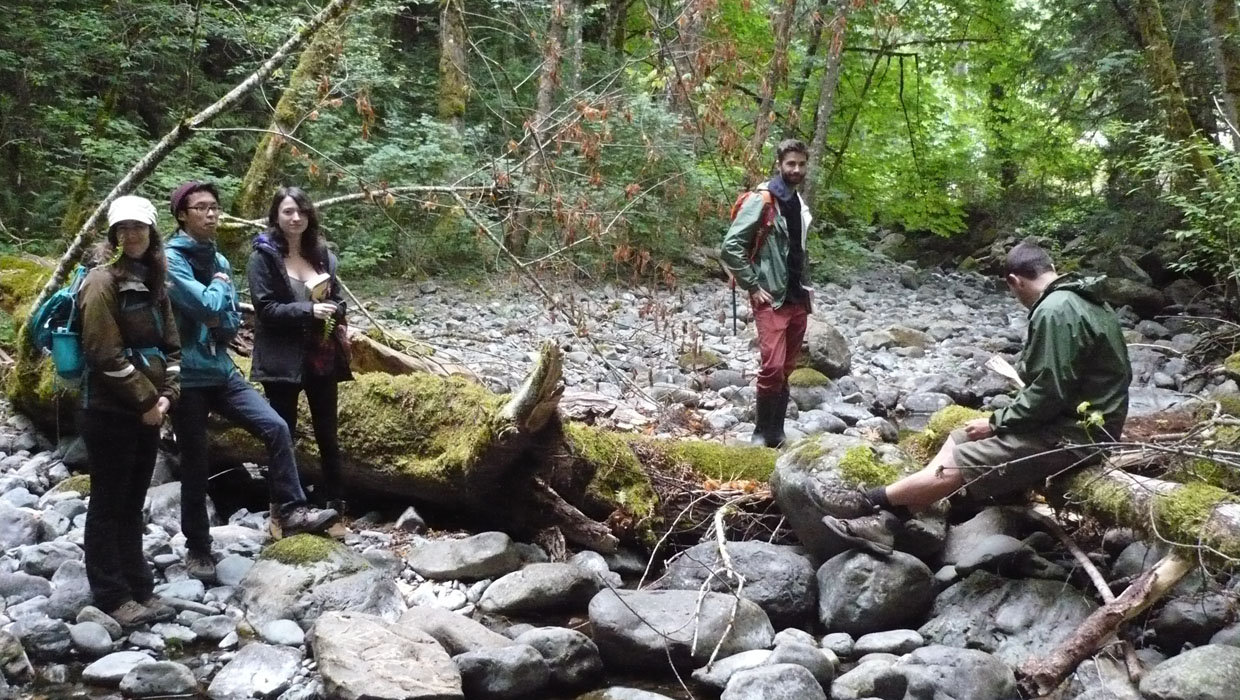On June 18th, TLC staff and volunteers visited the Ayum Creek Park Covenant located in Sooke. This covenant is one of the most diverse in terms of terrain: a Douglas-fir forest, creek and estuary all combine to make Ayum Creek a beautiful place to visit.
Volunteers checked the water levels of the creek at a meter stick permanently attached to the creek edge, showing how low the water level has already dropped… and it was only June! TLC staff will be visiting the creek again later this summer to determine just how low the lows get. This is important as this creek is a salmon-bearing stream, and low water levels mean it’s much harder (or impossible) for the salmon to swim further upstream when the time comes. Unfortunately, no amount of land or water protection can appease the rain gods, so we are at the whim of Mother Nature in terms of how much rain is afforded to the creek this summer.
Collecting ecological data and repeating established photopoints to track long-term landscape changes, the volunteers learned standardized data collection methods and why these are important for longitudinal studies. By expressing what is found in a systematic way, the results can be shared and used by other organizations.
Continuing onwards, the volunteers found remnants of a deer skeleton, including a complete jaw bone. At the end of the day, they also found a complete salmon jaw bone, and it was interesting to note the differences between the two!
Unfortunately, invasive species are also present at this beautiful site. Scotch broom, English ivy, English holly, daphne laurel and false lamium all plague Ayum Creek. Thankfully, this fall TLC will be joining efforts with Habitat Acquisition Trust (HAT) for a work party to remove these species! If you’re interested in joining, please get in touch with Torrey at covenants@conservancy.bc.ca for more information.
Thankfully, the site also hosts many interesting and beautiful native species. Turkey tail mushrooms (Trametes versicolor) have been clinically shown to have anti-cancer effects; entire-leaved gumweed (Grindelia integrifolia) has been used in traditional medicine for asthma and other bronchial irritations; rose hips infected with a fungus known as “rose rust”; sea asparagus (Salicornia spp.) with a stunningly orange-coloured little parasitic friend, the salt marsh dodder (Cuscuta salina) which, although it looks like silly string, is actually a plant; and the pretty little pacific bleeding heart (Dicentra formosa) plant that is aptly named, considering it’s flower. There was also an excellent example of baldhip rose and Nootka rose species, side by side. These two species can be hard to tell apart to the novice plant identifier, but one of the best ways to ID is the stem: baldhip rose stems have many fine, straight prickles on them, while the Nootka rose has thorns that are slightly curved, larger and more spaced out than the baldhip species.
Overall it was a very pleasant trip to Ayum Creek Park. As this covenant is publically accessibly, we highly encourage readers to visit this beautiful area, especially at low tide. Purple martin nest boxes have been added to the far end of the estuary, and chicks were heard when staff and volunteers visited last. Life is thriving at Ayum Creek, but don’t take our word for it – get out there and see!
Photo credit Torrey Archer.


































I was a streamkeeper on Ayum creek back in the late 1990s, when the estuary faced the threat of development. I volunteered with the Society for Protection of Ayum Creek to fundraise and purchase this property so that it could be protected in perpetuity. I also worked for the Western Canada Wilderness Committee on the creation of the Sea-to-Sea Blue-Green belt that stretches across the Sooke Hills down to Ayum Creek.
I am happy to see that this important coho habitat and estuary continues to be protected as a Regional Park with a covenant. I am upset that TLC is not affording the same degree of protection to Wildwood Ecoforest. The community helped TLC to raise over a million dollars to purchase Wildwood and protect it forever. Now TLC has decided to sell this iconic ecoforestry site to a private buyer. As TLC members, please become educated about what is happening with Wildwood Ecoforest. http://www.savewildwood.com